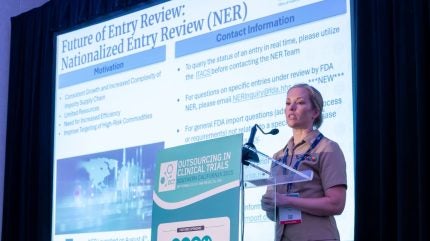
In August 2025, the US Food and Drug Administration’s (FDA) launched the nationalised entry review (NER) programme focused on centralising import reviews and moved away from the previous divisional structure.
This initiative was aligned with FDA Commissioner Dr Marty Makary’s vision and created to ensure consistency, address the growing complexity of the global supply chain, and make better use of limited resources, said FDA supervisory consumer safety officer Alyson Nicks at a recent conference.

Discover B2B Marketing That Performs
Combine business intelligence and editorial excellence to reach engaged professionals across 36 leading media platforms.
Nicks was speaking at the 13th Annual Outsourcing in Clinical Trials Southern California (OCTSC) 2025, which took place on 23-24 September in San Diego. By leveraging lessons from a 2022 pilot, the FDA is now applying a commodity-based review approach, supported by new technologies such as handheld rapid screening tests, AI, and machine learning in order to maximise staff efficiencies and target high-risk commodities.
According to Nicks, the goal is to ensure public health protections and make sure imported products meet US safety standards.
The programme highlights the FDA’s commitment to innovation, standardisation, and quick responses to emerging risks in an increasingly complex marketplace, as the new NER team serves as a single point of contact for brokers and filers, replacing division-specific contacts, said Nicks.
Five field divisions handle fieldwork and entry review processes, covering more than 300 ports of entry, which are the West Coast imports, Northern border, Southwest imports, Southeast imports, and Northeast imports.

US Tariffs are shifting - will you react or anticipate?
Don’t let policy changes catch you off guard. Stay proactive with real-time data and expert analysis.
By GlobalDataRequirements for pharmaceuticals and biologics
According to Nicks, all imported drugs must comply with quality, safety, and effectiveness standards, including registration, labeling, applications, and current Good Manufacturing Practices (cGMP) requirements.
The FDA reviews shipments, and imported products that appear adulterated, misbranded, or unapproved will be refused entry, she added. Entry declarations are compared to the FDA internal data systems to verify compliance, and any discrepancies may delay the importation process.
Nicks added that for pharmaceuticals, the FDA may check new drug applications (NDAs), abbreviated NDAs, investigational NDAs, and biologics licence applications (BLAs), along with labelling requirements that vary by product type, such as over the counter, prescription and investigational drugs.
She stated that for biologics regulated by Center for Biologics Evaluation and Research (CBER), the FDA verifies BLAs, IND numbers, and registration details. However, not all biological specimens fall under FDA jurisdiction.
If some specimens are strictly for clinical laboratory testing or basic scientific research, and not for prevention, diagnosis, or treatment, then brokers must disclaim FDA jurisdiction when transmitting them. However, Nicks underlined that if the specimens are intended for manufacturing, processing, or incorporation into drugs or devices they do fall under FDA jurisdiction and must comply with applicable requirements.
In addition, she adds that, products need to be labelled more specifically with an accurate description of the specimen, a statement of intended use, test results for infectious agents and relevant affirmations of compliance (AFC) codes.
Identifying high-risk commodities
According to Nicks, a high-risk commodity is defined by the FDA using PREDICT scores, which are system-generated risk assessments. More specifically, these scores factor in the product type, manufacturer, and transportation details to calculate an overall risk level and prioritise oversight.
For instance, produce is often classified as high-risk due to its susceptibility to contamination. Imports flagged as high-risk undergo closer scrutiny, either through detailed coding checks or direct inspection, to ensure safety before entering the US market.
Lastly, she emphasised that for investigational drug products, importers must hold an active IND number, which serves as the required authorisation for entry.





